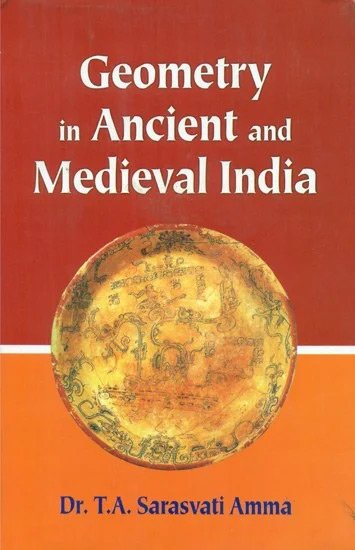Geometry in Ancient and Medieval India
author: Dr. T.A. Sarasvati Amma
edition: 2017, Motilal Banarsidass Publishers Pvt. Ltd.
pages: 278
language: English
ISBN-10: 8120813448
ISBN-13: 9788120813441
Topic: Jyotisha
Summary: This Book is a geometrical survey of the Sanskrit and Prakrit scientific and quasi-scientific literature of India beginning with the Vedic literature and ending with the early part of the 17th century. It deals in detail with the Sulba-sutras in the Vedic literature.
Buy now with free shipping!
Source: exoticindiaart.com
Introduction:
This book deals in detail with the Sulbasutras in the Vedic literature, with the mathematical parts of Jaina works and of the Hindu and with the contributions to geometry made by the astronomer- mathematicians Aryabhata I & II, Sripati, Bhaskara I & II, Sangamagrama Madhava, Paramesvara, Nilakantha, his disciples and a host of others. The works of the mathematicians Mahavira, Sridhara and Narayana Pandita and the Bakshali Manuscript have also been studied.
The work seeks to explode the theory that the Indian mathematical genius was predominantly algebraic and computational and that it eschewed proofs and rationales. There was a school in India which delighted to demonstrate even algebraical results geometrically. In their search for a sufficiently good approximation for the value of Indian mathematicians had discovered the tool of integration, which they used equally effectively for finding the surface area and volume of a sphere and in other fields. This discovery of integration was the sequel of the inextricable blending of geometry and series mathematics.
Available pages:
[About The Author]
[Foreword]
[Preface]
[Excerpts from reviews]
Contents of this online book (index):
The full text of the Geometry in Ancient and Medieval India in English can be quickly summarized in the following table of contents. Becaue these pages are not available to read online, I would recommend you buy the book.
Foreword V. Raghvan v
Preface vii
Chapter I. Introduction 1
Geometry as the branch of Indian mathematics with the earliest recorded development - the change from constructional character to circle-orientedness - lack of proofs explained - utilitarian character of Indian mathematics - general survey of the history of geometry and mathematics in India.
Chapter II. Sulbasutra Geometry 14
The number of Sulbasutras - their date - the term sulba - analysis of the contents of the Sulbasutras - the theorem of the square of the diagonal - determining the east-west line - to draw the perpendicular bisector of a given line - construction of squares, rectangles and trapezia - transformation of figures - combination and subtraction of areas - geometrical truths implied in the constructions - properties of similar figures - areas - rational right triangles - early geometrical terminology - the Sulbasutras and later ages.
Chapter III. Early Jaina Geometry 61
The impetus for the study of geometry - the very early works - the value 10 for solid figures - the trapezium and the trapezoidal solid.
Chapter IV. The Trapezium 70
The treatment in early Jaina literature, by Aryabhata I, by Brahmagupta, by Sridhara, by Mahavira, by later Jaina authors, by Aryabhata II, by Sripati, by Bhaskara II, by Narayana Pandit.
Chapter V. The Quadrilateral 81
The cyclic quadrilateral verses the non-cyclic-Suciksetras - non-cyclic quadrilaterals - Narayana Pandit’s treatment of the cyclic quadrilateral - Paramesvara’s expression for the circumradius and the Kriyakramakari proof for it - the Yuktibhasa proof for trigonometrical identities and for Brahmagupta’s expressions for the diagonals and area of a cyclic quadrilateral.
Chapter VI. The Triangle 117
Early mention of - treatment by Aryabhata, by Brahmagupta etc. - Nilakantha’s logical demonstration for the concurrence of the perpendicular bisectors of a triangle - the theorem of the square on the hypotenuse and its proof.-rational rectilinear figures - the rational cyclic quadrilateral - Narayana’s treatment of the rational trapezium-the rational right triangle in the Aryabhata school.
Chapter VII. The Circle 154
The circle in early work - Aryabhata I’s value of p by the method of exhaustion - series for p and close approximations to the value of p - finding the area of a circle - the segment and the chord - Madhava’s discovery of Gregory’s series - the common chord and its arrows - inscribed polygons - mutually touching circles.
Chapter VIII. Volumes and Surfaces of Solids 195
Volume in early works - the pyramid - Aryabhata I’s rue for the volume of a tetrahedron - pyramid-frustum and con-frustum - the sphere - the surface-area and volume of a sphere by integration.
Chapter IX. Geometrical Algebra 218
In the Sulbasutras - in the commentaries of Bhaskara II’s works - in the Aryabhata School Citrabhanu’s geometrical demonstrations of algebraical identities - sredhiksetras.
Chapter X. Shadow problems and other problems 251
Glossary of Geometrical Terms 261
Bibliography 267
Index 273
